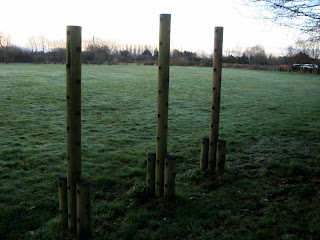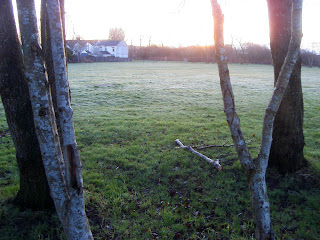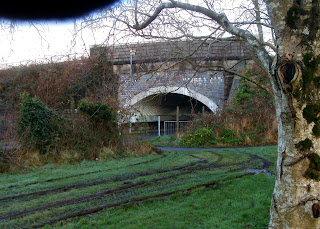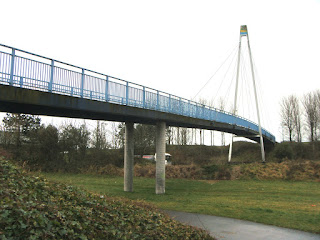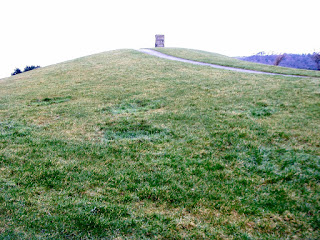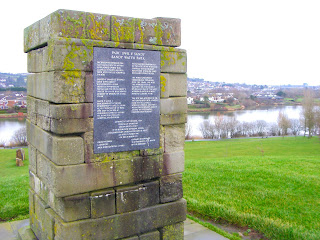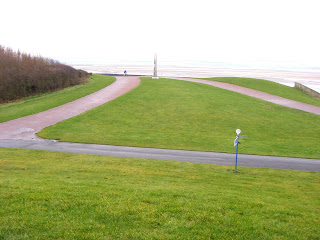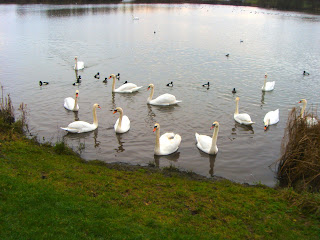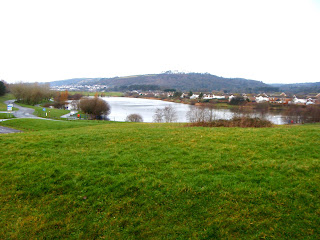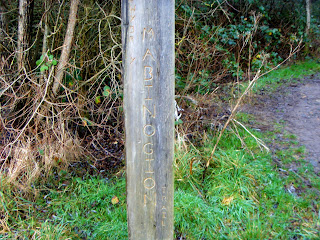Blogs
Sunshine and mild this morning. A good excuse to get up and out with the dogs. Bed is still warm and inviting but the opportunity is there to brave the elements and explore a little more of the countryside under my nose.
And as many people put their thoughts to a new regime of Health and Fitness in January, I took the opportunity of visiting another relic of Llanelli's history, the Old Castle Exercise and Fitness track. I have walked around the Old Castle fields many times and recall times from the past when I had taken the opportunity of running around the track and using the equipment that was built, open and free, for any passer by to use. Try as I might, I cannot find any records on Google of the building, financing, or the later dereliction of the track - but parts are still there to be seen.
Early sunshine rising over Old Castle ponds. Another Llanelli Blogger Robert Lloyd informs me that the Pond is over 40 feet deep in places, a place full of danger in the icy weather.
Indeed, I recall from my early days as a constable in Llanelli, assisting in the recovery of a body from the water. Details are blurred now, but the general consensus was that the deceased had fallen in, possibly drunk, while trying to climb around the metal railings that used to separate the grounds. It was a regular short cut from one end of town to the other. But the fencing required a little athletics to swing around over the water.
| |
| once there was a sign here |
This one has lost one of its struts, but it is almost at ground level. I recall them as being in a zig-zag, having to walk from one to the next - but there is little sign of this any more.
Here I think was a joint between two sets of balance bars - but only an empty pop bottle adorns the place now.
So - with one last look from the cycle track back onto the exercise fields -
I return under Sandy bridge the way I came. Certainly no fitter than when I arrived this morning, but having captured one more little part of Llanelli before it disappears entirely.
Another day - another walk around Llanelli area - this time - Sandy Water Park
The Llanelli Coastal Park Walk provides some wonderful scenery on the grounds of the old Steelworks, and before that - the old Mott and Bailey of Old Castle Works which may very well go back to pre Roman times.. and in my case some memories of the are over the last thirty five years.
We start today by Old Castle Ponds, at the base of the Agen Bridge. Where the cast iron sign post tells us that we are on route 47 - the chain links at the base holding up the details "Swansea 17 miles" Tumble 17 miles"
Climbing the unofficial pathway by the signpost up onto the Agen Bridge crossing the busy relief road from Weslec Roundabout to Union Bridge. Known officially as the Pont Agen Bridge.
I note the details from the Council deliberations:
INTRODUCTION
1.1. The Leader of the Council has received a letter from the Clerk to Llanelli Town Council suggesting that the new bridge over the B4304 at Sandy Waterpark be named "Pont Agen" and that the Mayor of Agen be invited to undertake the official unveiling.
2. BACKGROUND TO THE REQUEST
2.1. Members, I believe are already aware, during a recent visit to Llanelli's twin town of Agen in France, the Agen Council magnanimously named a street in the commercial sector of the town "Rue Llanelli", to mark the tenth anniversary of the twinning link between the two towns.
2.2. The Llanelli Town Council's Twinning Committee have now discussed the desirability of reciprocating this gesture and resolved that a request be made to the County Council for the new cycle/pedestrian bridge over the B4304 at Sandy Water Park to be named "Pont Agen".
2.3. Members of the Town Council considered that it is particularly appropriate for a bridge to be named in this fashion in view of the symbolic image which the bridge represents of the link that has been forged between the two towns of Agen and Llanelli.
2.4. A further pertinent point that influenced Members of the Town Council in their decision was the fact that they have extended an invitation to the mayor of Agen and some of his colleagues to visit Llanelli during the Eisteddfod week. As the bridge is scheduled to be completed before the Eisteddfod, the Town Council consider that it would be extremely opportune for the Mayor of Agen to be invited to undertake the official unveiling.
2.5. Members will be aware that the Millennium Coastal Park Board is considering names for the facilities/locations across the park. This bridge is located just outside the park and forms part of the Council's Llanelli and Coastal Corridor Sustainable Access Strategy which is being funded by Transport Grant Package Funding from the National Assembly of Wales. Due to the proximity and linkage of the bridge to the Millennium Coastal Park I have consulted the Project Director, Mr G Phillips, over this issue. He has confirmed that he has no views on the name as long as it says "Pont D'Agen or something Welsh and French".
2.6. If the Town Council's request meets with Members approval, I will then proceed to discuss the practicalities with the Town Clerk.
3. RECOMMENDATION
3.1. That the new cycle/pedestrian bridge is named "Pont Agen" and that Committee agree to the Town Council's suggestion that the Mayor of Agen be invited to undertake the official unveiling.
But from my point of view - it is a safe route across a busy road to the Millennium Park and Sandy Water Park.
Once across the bridge, one of the many sculptures raises its head. The leek and the daffodil. On a dark winter morning it is difficult to distinguish the bright colours of the green and the yellow - but they are stark in the skyline...
As you walk around the water edge, a large mound appears ahead of you - with a strange structure on top . To the right are some standing stones, not old and ancient, I have walked here for many years without seeing any stones.. but all paths lead up to the pile on thepinnacle.
Looking down from the top - we can see the Pwll end of the lake.
The Sculpture itself appears to be a pile of ingots - cast in stone rather than steel.
The plaque reads:
" Sandy Water Park..
Steel making commenced on this site in 1897 when the Llanelly Steel Company built their works on land reclaimed from the sea.
The Works underwent considerable expansion over the years and with the introduction of electric arc furnaces in 1978becameon of the most modern plants inEuropeprior to closure in 1981
The site was acquired in 1984 and developed into a water park by the Llanelli borough council and the welsh development agency as part of the coastal regeneration scheme."
But there are excellent views over the water park from the top...
looking back towards the railway and the sea - views out towards the Gower are dramatic. But of course as they say in Llanelli "If you can see the Gower from here - it is going to rain .. If you can't see the Gower - then it is raining !!"
Walking down from the sculpture there are benches and tables for the walker - though these days it seems that cyclists are more likely to be whizzing past at break neck speeds and bright in their Hi Vis Jackets. This table and seating is in the shape of a leaf and small leaves as seats. Sadly, one has been snapped off and not repaired...
Down to the water levels. In summer there are often signs warning of algaen bloom - poisons in the water from the early days of steel working I think - though how no-one thought that digging a pond on the site of a steelworks could ever provide fresh water!! I used to Wind-surf across this water, before they built the houses to watch my embarrassment !!
Now - we have the home for many swans - and this time of year they give due warning to the passer by that they do want too close a proximity.
Of course - over the later years - the houses have been built and then we had the Sandpiper - a pub with food on the site .
and then in 2012 - the final straw - a hotel on the site - Welcome to Travelodge !!
And that takes us around the whole of the park - back to the Bridge - to Weslec roundabout which I hear is soon to be a skateboard rink - but that is for the future - this is 2013 - January ... So some final views of the walk ..
Enjoy Llanelli. Enjoy the Scenery. Enjoy how history is changing.
Cardiff's most famous daughter, Shirley Bassey, was born on the 8th of January 1937 above the Canadian Cafe at 182 Bute Street, Tiger Bay, Cardiff. The address is significant. Shirley's mum was from the North east of England and her dad was Nigerian, and 1930s Tiger Bay has been described as the "The safest place in Britain for a man of colour". There were very few non white people living in pre-war Britain and outside parts of London and Liverpool Tiger Bay was the only place with a non white majority. The unique dockside culture was described as Indo-Cymric and Afro-Welsh. Loudon Square at the heart of the community was 80% non-white and so ethnically mixed that it was said that "you could see the world in one square mile". The rich ethnic mix gave rise to a distinct musical culture based on calypso and jazz and Tiger Bay was renowned for its clubs. During the war black GIs flocked to Cardiff whenever they got leave resulting in 73 local women marrying US servicemen and settling in the USA, including Shirley's sister, Grace.
Shirley's singing career started in the early 1950s and such was her talent that in just a few years her earnings went from 5 a week to $1800 a week in 1956 in Las Vegas; her first really big break. Her hits include Gold Finger, Diamonds are for Ever and Big Spender. She still performs and long may she continue to do so.
Lots more about the life and times of Cardiff at cardiffonfoot.com.
Tin Shed's 28th Infantry Division Appeal - Press Release - Please Circulate - Fire At Will
By Ceri Shaw, 2013-01-08
A small, volunteer run museum in Laugharne, west Wales is launching an appeal to commemorate the 70th anniversary of the arrival of a very special group of American soldiers to Wales in 1943.
Tin Shed Experience 1940s museum is appealing for information on the 28th Infantry Division known as the Keystones.
Seimon Pugh-Jones of the Tin Shed has been interested in this particular division for quite some time, he even produced a self funded documentary on the Americans in Wales during WWII entitled Operation Bolero. He says, I have always taken an interest in the 28th It is the oldest division in the armed forces of the United States but the most interesting thing to me about these troops is that they hail from Pennsylvania and of course that area of America has a large Welsh community that dates back to the late seventeenth century where a large emigration of Welsh Quakers occurred and then later in the 19th century where Welsh coal miners emigrated to the anthracite and bituminous mines.
He goes on, The division arrived in October 1943 and were here until April 1944. In a way a lot of the guys that were coming over to train in Wales were likely to be returning home to the land of their forebears.
They were based along the whole of the South Wales coastline from Porthcawl to Pembroke Dock. Recently a memorial was unveiled in Mumbles to some of the American forces based in that area during WWII, namely the 2nd Infantry Division. Seimon explains Unlike the 2nd Infantry Division what is also notable about the 28th is that they were citizen soldiers. The troops of the 28th are a national guard unit and came from similar working class backgrounds to the inhabitants of South West Wales. They share similar day to day occupations in agriculture and the coal and steel industries, they were from community orientated based towns similar to the people of Wales.
We have been told some lovely accounts over the years by people who remember the red Keystones (worn on the shoulder sleeve of their uniform) of just how well these troops integrated into the Welsh communities when they were over here.
They made a huge impact on the local communities and left a large hole when they left. They are fondly remembered and well regarded by the local people.
After leaving Wales the division was posted to Wiltshere then landed in Normandy, France on 22nd July 1944 and swept through Luxembourg and onto the German border where it sadly went on to suffer huge casualties in the Huertgen Forest at the famous Battle of the Bulge During WWII the red keystone insignia of the division became known to the German forces as the Bloody Bucket such was the ferocity of the fighting from the men wearing it.
Of the 14,032 GIs that came to Wales with the 28th Infantry, many would never see their homes and loved ones again. 9,609 men lost their lives, with another 884 reported missing in action.
Matthew Hughes of the Tin Shed explained What we would like is to have some sort of monument erected in our local area to these men. The beaches of Amroth, Wisemans Bridge, Saundersfoot and Tenby were all extensively used as practice grounds prior to the D-Day landings and would be fitting locations for a lasting reminder. General Eisenhower himself even visited the 110th infantry regiment of the division at Tenby in March 1944.
He goes on, We are currently working with a few organistations in Pennsylvania who are helping us appeal to veterans and families of veterans of the 28th. One such organization is the Wilkes-Barre / Scranton Penguins Ice Hockey team who are hosting a Welsh Heritage night on St. Davids day next year in conjunction with the The Welsh Cultural Endeavor of Northeastern Pennsylvania. We are also appealing through the AmeriCymru social network.
Mr. Brian Coe, Vice President of Operations at Wilkes-Barre/Scranton Penguins said The Welsh influence is apparent nearly everywhere you look in Northeast Pennsylvania and Luzerne County, from the rich coal mining history in the region to The Welsh Bethel Baptist Church in downtown Wilkes-Barre. When our ties during wartime were brought to our attention by the Tin Shed Experience, we were eager to help their research in any way possible. We hope that our fans and the people of the Wyoming Valley will be able to assist in the organizations research.
In closing Matthew Hughes said, In our opinion we believe that Wales is missing out on a large amount of American visitors each year. The families of American veterans spend vast amounts of money on month long trips to Europe visiting sites where their relatives trained along the South Coast of England fought in France, Belgium, The Netherlands and finally Germany. Wales has not been highlighted as a destination and to some of them it could be the first leg of their journey. The insignia of the 28th Infantry and the state of Pennsylvania is the keystone of a bridge. We hope that this symbol can take on a literal form through our appeal and hopefully a memorial could be another great way to highlight the importance of our shared heritages and encourage them across the Atlantic to visit.
If you have any information for the appeal please get in touch via www.tinshedexperience.co.uk
The Tin Sheds Operation Bolero documentary along with a few commemorative images they have created are now available for download for the first time via their online shop. The proceeds go to this memorial appeal and the upkeep of the museums exhibits
Click here to shop - http://www.tinshedexperience.co.uk/shop.html
Now that the third in The Carmarthen Underground series of books is out and selling like, er.....smallpox virus, those brilliant ideas that come to one in the far reaches of the night have started making their way to Madoc Leonard Towers.
Today, I've completed a rough draft of some song lyrics to go in the fourth and final book in the series. The song will be echoed in the book title as the working title I had for the book was bothering me and I've decided to change tack completely although the central event of the novel will be the same.
What I would like to do is to find someone willing to write some music (preferably for the harp) to go with the lyrics and then I'd have someone create a video of photographs of the Towy Valley to go with it. As I want this to be a professional and high-quality video, the photographs have to be equally professional. It would be nice to have the lyrics up on the screen as well. Naturally, there would be credits at the end for everyone concerned. Doing this on an invisible budget should be interesting!
As I've written only a couple of chapters and some notes for the book so far, there's time enough but at least I'm now making a start.
The various discussions on Americymru over the period of my membership have made me realise how little people know of us beyond our borders. I feel that I'd like to use this novel, in part, to further people's knowledge of Wales so there'll be some research to be done (and not just eating Welsh chocolates or drinking Welsh beer and whisky although I hope to do some of that!). A Twitter friend has already given me one idea to incorporate into the story so I'll see what else I can come up with.
I've got a strong idea of how I want the cover to look too so that should help get some chapters done in the next few weeks, I hope.
After reading Philip Stephen Rowland excellent blog entitled We Was Brung Up Proper I came across this post which reminded me of Philip's blog. I am not the author and the post was not credited. It simply said the writer observed an elderly woman at the grocery market. He observed her being gently scolded by the cashier when she requested "Plastic..."
Checking out at the supermarket recently, a young cashier suggested that an elderly woman in front of me should bring her own bags because plastic bags werent good for the environment. The elderly woman kindly accepted this public rebuke and apologized explaining, We didnt have this green thing back in my day .
The clerk responded, Thats the problem. Your generation did not care enough to save the environment for our generation today ."
I was a bit younger than the elderly woman in front of me but the cashier's words caused me to think.
She was right about one thingour generation didnt have the green thing in Our day. So what did we have back then? After some reflection and soul-searching on Our day, heres what I remembered we did have.
Back then, we returned milk bottles, pop bottles and beer bottles to the store. The store sent them back to the plant to be washed and sterilized and refilled, so it could use the same bottles repeatedly. So they really were recycled. But we didnt have the green thing back in our day.
We walked up stairs, because we didnt have an escalator in every store and office building. We walked to the grocery store and didnt climb into a 75-horsepower machine every time we had to go two blocks. But she was right. We didnt have the green thing in our day.
Back then, we washed the babys nappies because we didnt have the throw-away kind. We dried clothes on a line, not in an energy gobbling machine burning up 230 volts 50 Hz wind and solar power really did dry our clothes back in our early days. Kids got hand-me-down clothes from their brothers or sisters, not always brand-new clothing. But that young lady is right. We didnt have the green thing back in our day.
Back then, we had one TV, or wireless, in the house not a TV in every room. And the TV had a small screen the size of a handkerchief (remember them?), not a screen the size of Wales. In the kitchen, we blended & stirred by hand because we didnt have electric machines to do everything for us. When we packaged a fragile item to send in the mail, we used wadded up old newspapers to cushion it, not Styrofoam or plastic bubble wrap.
Back then, we didnt fire up an engine and burn petrol just to cut the lawn. We used a push mower that ran on human power. We exercised by working so we didnt need to go to a health club to run on treadmills that operate on electricity. But shes right. We didnt have the green thing back then.
We drank from a water fountain when we were thirsty instead of using a cup or a plastic bottle every time we had a drink of water. We refilled writing pens with ink-fillers instead of buying a new pen, and we replaced the razor blades in a razor instead of throwing away the whole razor just because the blade got dull. But we didnt have the green thing back then.
Back then, people took the bus, and kids rode their bikes to school or walked instead of turning their mums into a 24-hour taxi service. We had one electrical outlet in a room, not an entire bank of sockets to power a dozen appliances. And we didnt need a computerized gadget to receive a signal beamed from satellites 24,000 miles out in space in order to find the nearest fish and chips shop.
But isnt it sad the current generation laments how wasteful we old folks were just because we didnt have the green thing back then?
Monday in January. The Wales Coast Path website proudly proclaims :
Sandy Water Park & The Mabinogion Woods Sculpture Trail Millennium Coastal Park, Llanelli SA15 2LF.
Large lake with interesting birdlife and numerous Swans, including a trail through the woods with Mabinogion inspired sculptures.
This morning I strolled across the Agen Bridge into Sandy Water Park, once home of the Steelworks, now part of the coastal cycle path SUSTRANS, and part of the Millennium Coastal Path, the "Carmarthenshire Bit" as they say on the website. Considering that we have had the wettest year in history according to the pundits, this was the seventh day of the new year where I managed to walk without need for waterproofs. But this morning I was concerned with the heroic age or mythological past of the British Isles, the eleven stories of the Mabinogion, and the path that winds through the woods at the eastern edge of the water park.
 |
| Entrance to the Path |
It would be quite easy to miss the entrance to the path if you are unaware of its location. It is by the car park - but there are no sings pointing to the entrance. Just a single post, and you have to get right up to it to find the writing thereon..
The carving is not very clear - but at least you now know that you are on the right road. A closer look at the post and you can see that there are further carvings at the top of the post.
As you enter the path, through the clearing you can see the first of the sculptures. A cast iron boar.
He is well weathered and I have visited him often as I walk the dogs - and he only improves with age.
 |
| The Boar |
The boar is in a small clearing with a two small benches suitable for sitting and contemplating the whichness of the why, but for the busy dog-walker it is back to the path and through the trees. The whole site used to be the Steelworks, and the trees and features have all been planted and grown in the time I have lived in Llanelli. I used to drive through the area in a police car in the early eighties. The Duport Electric Arc Furnace at Pwll was one of the finest in the country they say, though I recall it mainly for the sound of the locomotive pulling the metal from the interior in the early hours of the morning as I tried to sleep in the police house opposite. But the trees are fast growing and now well established.So I walked on in search of the remainder of the sculptures. I remember the stag, and the owl, had I missed any in my previous perambulations?
And so, as I got half way through the path, I came to the sad sight of the post that once held the Stag. Similar to the boar, it stood in pride of place atop another post... but all I was met with was the broken stump of the stand.
Through to the end of the path, and no sign of any other sculpture. the Owl that I recalled was nowhere to be found. No other animals or relics of Mabonigion tales to be seen . Only the simple post at the other end of the path. this too held the legend of the path... but no suggestion that the path had been denuded.
As I left the path, I met with one of the groundsmen, clearing some rubbish from the site. I asked about the stag.
"It is safe" he told me. "The post was vandalised but we managed to keep the stag and it is in the depot while we wait to see what we are going to do with it." I will try to visit the depot and see where it is...
"But the owl", he confided, "we never found.... The post was broken and the owl stolen. We haven't seen it since"
Once more, I leave my walk a little saddened.
 From the Barkeep's Blog
From the Barkeep's Blog
For anyone who is not aware of this 'cult' TV show here is what the Wiki has to say about it:-
Lost Girl is a Canadian supernatural crime drama television series that premiered on Showcase on September 12, 2010. The series was created by Michelle Lovretta, and is produced by Prodigy Pictures, in association with Shaw Media . It follows the life of a succubus named Bo , played by Anna Silk , as she learns to control her abilities, helps those in need, and discovers the truth about her origins. Following good ratings and positive reviews, it was renewed for its second season two months after its premiere, [ 4 ] and for its third season in December 2011. [ 5 ]
In Australia, Lost Girl premiered on Sci Fi Australia on July 14, 2011. [ 6 ] In the United Kingdom, it premiered on Syfy (United Kingdom) on September 1, 2011. [ 7 ] In the United States, it premiered on Syfy on January 16, 2012. [ 3 ] [ 8 ]
And the Welsh connection? The actor ( Paul Amos ) who plays the none too charming 'Vex' is from Pencoed near Bridgend. Here is what wiki has to say about him:-
Paul Amos as Vex: A Mesmer. He can control people's actions against their will. Vex is of the dark Fae and "friends" with the Morrgan. He played a pivotal role against the Garuda where he used his powers to delay the Garuda in using Trick's blood to change the Blood Laws. He has a childish personality and uses his powers to amuse himself in such ways.
If you haven't caught up with the show yet you can find 35 episodes on Netflix but be aware that for all its frivolity it is very much an adult themed series. If you thrilled to 'True Blood' you will love 'Lost Girl' and it is after all:- "the highest-rated Canadian scripted series premiere of all time on Showcase".
Here is Paul Amos' IMDB entry : - Paul Amos on IMDB
2012 West Coast Eisteddfod Online Poetry Competition winner Paul Steffan Jones reads his 2013 submission 'Song of David'
I walked across the old grounds of Stradey Park Rugby Football ground. That is not difficult, as it is only a couple of hundred yards away from the house, in fact it used to be rumoured that I would lean out the back window and yell "Can you keep the noise down - some people are trying to sleep here !" when a match was on... But though I used to walk that way regularly, I have not been that way since the fences went up and the buildings started getting knocked down.
Now, I do not consider myself to be much of a Rugby fan. Before you jump down my throat, I live in Llanelli, I have lived here for 35 years, but I am not Welsh, I was born in Glasgow and raised in London. I am not native Llanelli, and it is quite possible, though difficult, to survive in this town without having a religious fervour for the game with the funny shaped ball. There - I have said it!!! But then most of my friends know that about me already.
As a young constable in Llanelli, I tried hard to fit in and enjoy the game. But there was a tendency for one policeman to be watching the crowd when on "Crowd Control" duty. It was partly because I did not wear contact lenses in those days - they were rather new technology. And my glasses really never fitted very well under my cap. Yes, we had caps in those days before we had the "Bobby" helmet. Dyfed-Powys Police were different that way. They called us "Pongos" in training school. So watching the game was rather pointless as I could net really see the action on the field. So I watched the spectators instead.
After a few months I thought the whole matter through. Saturday afternoons were Rugby Afternoons. This involved getting to your traffic "point" for traffic control about 2 hours before the match. Best to remember to go to the loo before taking point. There is very little opportunity to relieve yourself once you are at the junction directing traffic! No extra cup of tea that morning! Then after the game starts the van pulls up and you get a lift to the ground, sneak in the side entrance by the South Stand and make your way around to the Town end, moreaffectionatelyknown as the Tanner Bank. Twenty minutes before the end, regardless of how exciting the game was, you were once more in the van heading for another two hour Traffic Point, hoping that someone would remember to pick you up - or face a long walk back to the station..
Yes - I thought it through - all self respecting Llanelli criminals were naturally Scarlet Supporters! They were little different from any other member of the populace other than their criminal activities, so they would of course be at the match. Thus, likelihood of any criminality during the match was marginal. Domestic Disputes would not really flare up until at least half a dozen pints after the match ... most shops were shut, and there were no vehicles on the road. So it seemed only natural to volunteer to "look after the town" while the match was on - an act of selfless altruism which allowed all my rugby fanaticalcolleaguesto watch the match while I took on the arduous task of finding a nice warm place with a cup of tea, radio by my side, to ensure that the town was "Safe".
And so it was for many years that I found the quietest time of the week was match day in Llanelli.
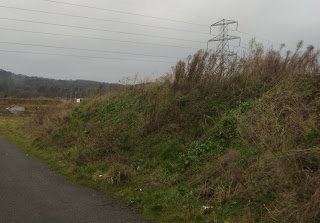 |
| Tanner Bank |
But walking around the grounds now, there is a mound where the tanner bank used to be. Temporary fencing around the whole site - but gaps where the fencing has fallen and the once verdant turf is now indistinguishable from the rest of the tufts of course grass. Local complainers always said that there would be trouble trying to build housing on this site due to the drainage problems - the ground is wet but there is still history here. You can almost see the score boards in the puddles.
 |
| 9 - 3 |
So now I do not have to lean out and ask them to keep the noise down. But it is almost as though sad ghosts of the past were by my side as I wandered along the touchline once more. They were no more distinct than the players I failed to see in the past, but now as then - I feel sure that they are there..



